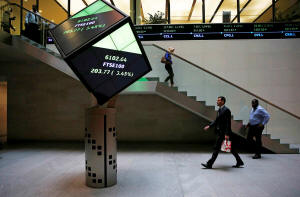Stocks mixed; 'indestructible' gold passes $2,100
 Send a link to a friend
Send a link to a friend
 [December 04, 2023] By
Nell Mackenzie and Wayne Cole [December 04, 2023] By
Nell Mackenzie and Wayne Cole
LONDON/SYDNEY (Reuters) -Global shares were mixed on Monday, while gold
spiked to all-time peaks above $2,100 at the start of a busy week for
economic data that will test market wagers on rate cuts from major
central banks next year.
MSCI's broadest index of world shares rose 0.1% after hitting a fourth
month high in earlier trading. However, Europe's STOXX 600 benchmark
fell 0.1%.
European retailers enjoyed an early "Santa Rally" as the index of top
retailer shares traded up 1.1% to its highest since March 2022. But any
early holiday cheer was offset by losses in the basic resources index,
which fell 1.7%, undermined by lower copper prices. [MET/L]
Attacks on commercial vessels in the Red Sea on Sunday risked reigniting
investor worries about a widening of the war between Israel and Hamas,
potentially complicating the outlook for a rally that saw U.S. stocks
crest a fresh closing high for the year last week.
But front of mind for analysts and traders was the U.S. November
payrolls report due on Friday, which needs to be solid enough to support
the economic soft-landing scenario, but not so strong as to threaten the
chance of easing. Median forecasts see payrolls to rise 180,000, keeping
unemployment steady at 3.9%.

Wage growth still sits above the Fed's target, said Bruno Schneller,
managing director at INVICO Asset Management. If upcoming data aligns
with expectations, it could mean the end of rate hiking this year and a
shift to cuts in 2024.
"Considering the upcoming 2024 U.S. presidential election, the Fed will
likely avoid actions that could be perceived as favouring any candidate,
leading us to expect no major surprises and a continued data-dependent
approach from the Fed," said Schneller.
Futures now imply a 60% chance the Fed will ease as soon as March, up
from 21% a week ago, and are pricing in around 135 basis points (bps) of
cuts for all of 2024.
The turnaround in Treasuries has been nothing short of astonishing as
two-year yields fell 41 bps in just a week, the best performance since
the mini-crisis in the U.S. bank sector in March.
So it was no surprise that some profit-taking emerged on Monday and
nudged yields on 10-year notes up to 4.25%, but still well short of the
October top of 5.02%.
BULLISH FOR EM
"Starting in June, we expect the Fed to start cutting rates by 25bp per
quarter until reaching a terminal rate of 3% in 2026," BofA global
economist Claudio Irigoyen said.

[to top of second column] |

People walk through the lobby of the London Stock Exchange in
London, Britain August 25, 2015. REUTERS/Suzanne Plunkett/File Photo

"Our year-end 2024 U.S. rate forecasts for two-year and 10-year
Treasuries are 4.00% and 4.25%, bringing an end to the yield curve
inversion," he added.
Such an outlook should also be positive for emerging markets. BofA
noted returns in the 12 months after the last Fed hike tend to be
highly positive, with EM equities averaging around 10% and total EM
bond returns even higher.
Central bank meetings in Canada and Australia this week are both
expected to see rates there unchanged.
The tumble in Treasury yields in turn pulled the rug out from under
the dollar, particularly against the yen, where it slid 1.8% last
week and was last down at 146.63.
Speculation about an eventual unwinding of the Bank of Japan's
super-loose policies has added to the pressure on yen carry trades
and could carry the Japanese currency back to its July highs around
138.00.
The euro ticked down 0.1% to $1.0875. It has also been climbing
recently, but suffered a reversal last week when surprisingly soft
inflation data led markets to price in a March rate cut from the
European Central Bank.
The dollar rose 0.2% against a basket of currencies =USD while US
stock futures pointed over 0.3% lower,.
The ever-hawkish Bundesbank President Joachim Nagel pushed back
against the doves in an interview over the weekend. But with
inflation subsiding so fast markets figure the ECB will have to ease
just to stop real rates from rising.
ECB President Christine Lagarde will have her own chance to comment
in a speech and Q&A later on Monday.
The dive in yields and the dollar has been a boon for non-yielding
gold, which hit a record of $2,111.39 an ounce [GOL/] before sliding
back to $2,071.50 an ounce by 0945 GMT.

Oil prices dropped on doubts that OPEC+ will be able to maintain
planned output cuts. Underlining this, U.S. oil production is at
record levels above 13 million barrels a day and rig counts are
still rising. [O/R]
The attacks on shipping in the Red Sea offered only fleeting support
and Brent eased 60 cents to $78.28 a barrel, while U.S. crude fell
57 cents to $73.52 at 0954 GMT.
(Reporting by Wayne Cole; Editing by Sam Holmes, Kim Coghill and
Alison Williams)
[© 2023 Thomson Reuters. All rights
reserved.]
This material may not be published,
broadcast, rewritten or redistributed.
Thompson Reuters is solely responsible for this content. |